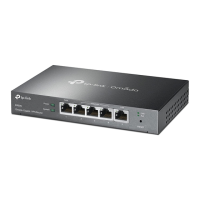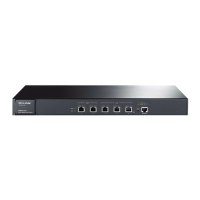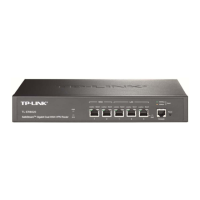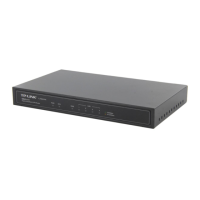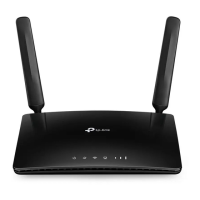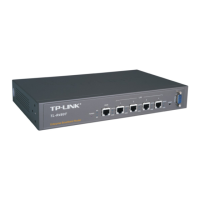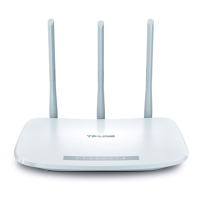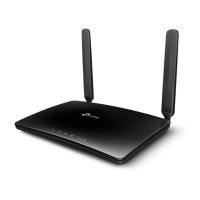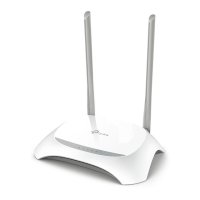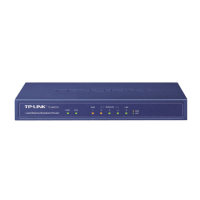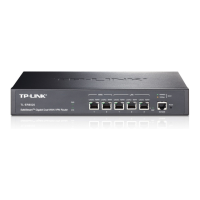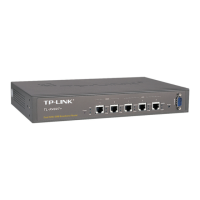Do you have a question about the TP-Link TL-SG2424 and is the answer not in the manual?
Identifies the target audience for the guide, assuming familiarity with IT concepts and network terminology.
Explains the conventions used in the guide, such as abbreviations and formatting for menu items.
Outlines the guide's structure and provides a brief introduction to the content of each chapter.
Provides a general overview of the switch's capabilities and design for workgroups and departments.
Highlights the key features of the switch, including resiliency, Layer 2 switching, QoS, and manageability.
Describes the physical appearance of the switch, focusing on front and rear panel components.
Details the process of accessing the switch's configuration utility via a web browser.
Explains how to navigate the main setup menu after a successful login.
Covers system configuration, including summary, device description, time, IP, and IPv6 settings.
Details how to configure user accounts and access levels for managing the switch.
Explains system tools for managing configuration files, firmware, and rebooting/resetting the switch.
Provides security measures for remote login to enhance configuration management security.
Covers basic port configurations, including port settings, mirroring, security, isolation, and loopback detection.
Explains Link Aggregation Group functionality for combining ports for higher bandwidth and reliability.
Details how to monitor port traffic and analyze network abnormalities.
Covers MAC address table management, static, dynamic, and filtering address configurations.
Explains how to configure DHCP filtering to protect the switch from illegal DHCP servers.
Details the 802.1Q VLAN protocol for identifying and managing VLAN-tagged packets.
Provides a practical example demonstrating the implementation of 802.1Q VLANs.
Covers global configuration of Spanning Tree Protocol (STP) and its parameters.
Allows configuration of port parameters for Spanning Tree Protocol (STP) and MSTP.
Explains Multiple Spanning Tree Protocol (MSTP) instance configuration for load balancing.
Details security features to protect against malicious attacks on Spanning Tree Protocol.
Illustrates a practical application example for Spanning Tree Protocol (STP) functionality.
Explains IGMP Snooping for controlling multicast traffic by monitoring IGMP messages.
Details MLD Snooping for efficient distribution of IPv6 multicast data.
Allows viewing IPv4 and IPv6 multicast groups currently present on the switch.
Covers traffic classification and mapping of packets to priority queues for QoS implementation.
Explains bandwidth control features like rate limiting and storm control for network traffic management.
Details Voice VLAN configuration for prioritizing voice data streams and ensuring voice quality.
Covers Access Control List configuration, including summary, creation, MAC, Standard-IP, and Extend-IP ACLs.
Explains policy configuration, linking ACLs with actions to control data packets.
Details binding policies to ports or VLANs to enforce their effect on network traffic.
Provides a practical application example of Access Control List (ACL) implementation.
Covers PoE configuration, including system power limits and port-specific settings.
Allows configuration of time-ranges for PoE power supply, including holidays.
Covers SNMP configuration including global settings, views, groups, users, and communities.
Details the notification function for reporting important events to the management station.
Explains Remote Monitoring capabilities for network traffic monitoring and statistics.
Covers basic LLDP configuration, including global and port-specific parameters.
Allows viewing LLDP information for local devices and their neighbors.
Enables viewing LLDP statistics of the local device through the interface.
Details LLDP-MED configuration for managing endpoint devices like IP phones.
Monitors switch CPU and memory utilization rates to detect potential network issues.
Provides functionality to record, classify, and manage system information and errors.
Offers tools for device diagnostics, including cable testing to locate network problems.
Includes Ping and Tracert functions for testing network connectivity and reachability.
Identifies the target audience for the guide, assuming familiarity with IT concepts and network terminology.
Explains the conventions used in the guide, such as abbreviations and formatting for menu items.
Outlines the guide's structure and provides a brief introduction to the content of each chapter.
Provides a general overview of the switch's capabilities and design for workgroups and departments.
Highlights the key features of the switch, including resiliency, Layer 2 switching, QoS, and manageability.
Describes the physical appearance of the switch, focusing on front and rear panel components.
Details the process of accessing the switch's configuration utility via a web browser.
Explains how to navigate the main setup menu after a successful login.
Covers system configuration, including summary, device description, time, IP, and IPv6 settings.
Details how to configure user accounts and access levels for managing the switch.
Explains system tools for managing configuration files, firmware, and rebooting/resetting the switch.
Provides security measures for remote login to enhance configuration management security.
Covers basic port configurations, including port settings, mirroring, security, isolation, and loopback detection.
Explains Link Aggregation Group functionality for combining ports for higher bandwidth and reliability.
Details how to monitor port traffic and analyze network abnormalities.
Covers MAC address table management, static, dynamic, and filtering address configurations.
Explains how to configure DHCP filtering to protect the switch from illegal DHCP servers.
Details the 802.1Q VLAN protocol for identifying and managing VLAN-tagged packets.
Provides a practical example demonstrating the implementation of 802.1Q VLANs.
Covers global configuration of Spanning Tree Protocol (STP) and its parameters.
Allows configuration of port parameters for Spanning Tree Protocol (STP) and MSTP.
Explains Multiple Spanning Tree Protocol (MSTP) instance configuration for load balancing.
Details security features to protect against malicious attacks on Spanning Tree Protocol.
Illustrates a practical application example for Spanning Tree Protocol (STP) functionality.
Explains IGMP Snooping for controlling multicast traffic by monitoring IGMP messages.
Details MLD Snooping for efficient distribution of IPv6 multicast data.
Allows viewing IPv4 and IPv6 multicast groups currently present on the switch.
Covers traffic classification and mapping of packets to priority queues for QoS implementation.
Explains bandwidth control features like rate limiting and storm control for network traffic management.
Details Voice VLAN configuration for prioritizing voice data streams and ensuring voice quality.
Covers Access Control List configuration, including summary, creation, MAC, Standard-IP, and Extend-IP ACLs.
Explains policy configuration, linking ACLs with actions to control data packets.
Details binding policies to ports or VLANs to enforce their effect on network traffic.
Provides a practical application example of Access Control List (ACL) implementation.
Covers PoE configuration, including system power limits and port-specific settings.
Allows configuration of time-ranges for PoE power supply, including holidays.
Covers SNMP configuration including global settings, views, groups, users, and communities.
Details the notification function for reporting important events to the management station.
Explains Remote Monitoring capabilities for network traffic monitoring and statistics.
Covers basic LLDP configuration, including global and port-specific parameters.
Allows viewing LLDP information for local devices and their neighbors.
Enables viewing LLDP statistics of the local device through the interface.
Details LLDP-MED configuration for managing endpoint devices like IP phones.
Monitors switch CPU and memory utilization rates to detect potential network issues.
Provides functionality to record, classify, and manage system information and errors.
Offers tools for device diagnostics, including cable testing to locate network problems.
Includes Ping and Tracert functions for testing network connectivity and reachability.
| Switching Capacity | 48 Gbps |
|---|---|
| Forwarding Rate | 35.7 Mpps |
| Power Supply | 100-240VAC, 50/60Hz |
| Mounting | Rack mountable |
| Jumbo Frame | 9KB |
| Standards and Protocols | IEEE 802.3, IEEE 802.3u, IEEE 802.3ab, IEEE 802.3x |
| Layer | Layer 2 |
| Dimensions | 440 x 180 x 44mm (17.32 x 7.09 x 1.73in) |
| MAC Address Table | 8K |
| Quality of Service | 802.1p |
| L2 Features | Port Mirroring |
| VLAN | 802.1Q VLAN |
| Access Control List | Yes |
| Security | DHCP snooping |
| Management | Web-based GUI |
| Operating Temperature | 0°C to 40°C |
| Storage Temperature | -40°C to 70°C |
| Operating Humidity | 10%~90% non-condensing |
| Storage Humidity | 5% to 90% non-condensing |
| Ports | 24 x 10/100/1000Mbps RJ45 ports, 4 x 1G SFP slots |
